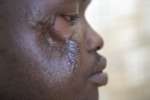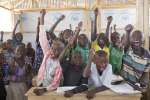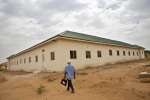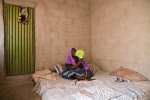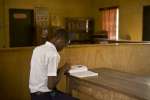Some 16,000 refugees seek shelter in Cameroon following clashes in north-east Nigeria
News Stories, 3 March 2015
DAKAR, Senegal, March 3 (UNHCR) – The UN refugee agency reported on Tuesday that some 16,000 Nigerian refugees fled to Cameroon's Far North region over the weekend to escape clashes in north-east Nigeria between regional military forces and insurgents.
The Cameroonian authorities told UNHCR that the refugees had come from villages caught in the fighting along the border, and more continued to cross into the extremely volatile border zones, including Makaria, Logone Birni and Fotokol, which lie just south of Lake Chad and have come under attack by Nigerian insurgents in recent weeks.
UNHCR is working with Cameroon to relocate refugees as quickly as possible away from areas of active conflict to a transit site at Kousseri, which lies 90 kilometres from the border and 370 kilometres north of Minawao, where there is an established refugee camp.
"Because of conflict between military forces and insurgents happening on Cameroonian territory, we do not have access to border areas where refugees have arrived," UNHCR spokesman Adrian Edwards told journalists in Geneva, adding that the agency and partners were ready to conduct screening at the transit site and to provide emergency assistance in health, nutrition, water and food for new arrivals.
Relocation convoys from the border to Kousseri will begin on Wednesday. Following screening procedures, UNHCR will then organize daily transfers of 2,000 refugees to Minawao camp where urgent shelter and sanitation construction is under way. At Minawao, UNHCR will also be providing basic relief aid, such as blankets, kitchen sets and soap. The camp currently hosts more than 32,600 Nigerian refugees.
Edwards said the government of Cameroon continues to provide critical escorts for humanitarian and relocation convoys to ensure the physical protection of refugees and humanitarian actors.
"Because of the evolving security situation in the region and the prospect of more refugee arrivals, we are discussing the setting up of a second refugee camp, further away from the insecure border. Given the scarcity of water in the area around Minawao, we are looking to secure a second camp location that will provide adequate levels of potable water for a rapidly growing refugee population in the Far North region," he said.
Once screening has been completed, these latest movements are expected to bring the total number of Nigerian refugees in Cameroon to nearly 66,000, of whom some 41,500 have already been verified by UNHCR.
Meanwhile in Niger, insurgent attacks in early February on Bosso and Diffa towns have resulted in a deterioration in the humanitarian situation in the area, with the internal displacement of an estimated 50,000 people towards the city of Zinder (located 500 kms west of Diffa town) and across the Diffa region. UNHCR teams report that people are progressively returning to their homes in Diffa, while Bosso remains virtually empty.
UNHCR, with regional authorities, UN agencies and NGO partners, carried out a rapid evaluation in the Diffa region at the sites hosting displaced people. The situation is particularly worrying around Lake Chad and access to these populations, who are in dire need of food, water and shelter, is seriously constrained. A sharp rise in prices of food and basic commodity items at the local markets further compounds the difficult socio-economic situation of both the displaced population and the host community.
In the western part of the Diffa region, UNHCR and the country's National Commission of Eligibility will soon recommence the voluntary relocation of refugees from host villages at the border to the Sayam Forage refugee camp, located 50 kms north of the border. "We are also working to establish another site for refugees or internally displaced persons, should the situation in Diffa region continue to deteriorate," Edwards noted.
More than 100,000 people have found refuge in Niger in the past two years, including Nigerian refugees and returning nationals of Niger, according to the authorities. Last week, the state of emergency in the Diffa region was extended for an additional three months by the Niger parliament.
The conflict in north-east Nigeria has also forced some 18,000 people to flee to western Chad, including more than 15,000 since early January after major attacks on the town of Baga in Nigeria's Borno state. To date, UNHCR has moved over 3,800 of them to the site of Dar es Salam. In addition, close to a million people are internally displaced in north-eastern Nigeria, according to the Nigeria Emergency Management Agency.





